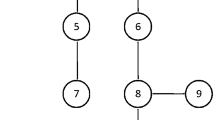Abstract
In this paper, the problem of locating new facilities in a competitive environment is considered. The problem is formulated as the firm expected profit maximization and a set of nodes is selected in a graph representing the geographical zone. Profit depends on fixed and deterministic location costs and, since customers are independent decision-makers, on the expected market share. The problem is an instance of nonlinear integer programming, because the objective function is concave and submodular. Due to this complexity a branch & bound method is developed for solving small size problems (that is, when the number of nodes is less than 50), while a heuristic is necessary for larger problems. The branch & bound is called data-correcting method, while the approximate solutions are obtained using the heuristic-concentration method.
Similar content being viewed by others
References
Benati, S. (1997). “Submodularity in Competitive Location Problems.” Ricerca Operativa 26, 3–34.
Benati, S. (1999). “The Maximum Capture Problem with Heterogeneous Customers.” Computers and Operations Research 26, 1351–1367.
Benati, S. (2000). “NP-Hardness of Some Competitive Location Models with Random Utilities.” Studies in Locational Analysis 14, 211–232.
Benati, S. and P. Hansen. (2002). “The Maximum Capture Problem with Random Utilities: Problem Formulation and Algorithms.” European Journal of Operational Research 143, 518–530.
Berman, O. and K. Dmitry. (1998). “Flow Intercepting Spatial Interaction Model: A New Approach to Optimal Location of Competitive Facilities.” Location Science 6, 41–65.
Brimberg, J., P. Hansen, N. Mladenović, and E.D. Taillard. (2000). “Improvements and Comparison of Heuristics for Solving the Multisource Weber Problem.” Operations Research 48, 440–460.
Choi, D.S., W.S. Desarbo and P.T. Harker. (1990). “Product Positioning Under Price Competition.” Management Science 38, 175–199.
Drezner, T. and Z. Drezner. (1996). “Competitive Facilities: Market Share and Location with Random Utility.” Journal of Regional Science 36, 1–15.
Eiselt, H.A. and G. Laporte. (1997). “Demand Allocation Functions.” Location Science.
Fotheringham, A.S. and M.E. O'Kelly. (1989). Spatial Interaction Models: Formulations and Applications. Dordrecht: Kluwer.
Goldengorin, B. (1995). “Requirements of Standard: Optimization Models and Algorithms.” Russian Operations Research. Hoogezand, The Netherlands.
Goldengorin, B., G. Sierksma, G.A. Tijssen, and M. Tso. (1999). “The Data-Correcting Algorithm for the Minimization of Supermodular Functions.” Management Science 45, 1359–1551.
Hakimi, S.L. (1990). “Locations with Spatial Interactions: Competitive Location and Games.” In Mirchandani and Francis (eds.), Discrete Location Theory. New York: Wiley.
Hansen, P. and N. Mladenović. (1998). “Variable Neighbourhood Search for the p-Median Problem.” Location Science 5(4), 207–226.
Hansen, P. and N. Mladenović. (1999). “An Introduction to Variable Neighborhood Search.” In S. Voss et al. (eds.), Metaheuristics, Advances and Trends in Local Search Paradigms for Optimization. Dordrecht: Kluwer, pp. 433–458.
Hansen, P., N. Mladenović, and D. Perez-Brito. (2001). “Variable Neighborhood Decomposition Search.” Journal of Heuristics 7, 335–350.
Leonardi, G. (1983). “The Use of Random Utility Theory in Building Location–Allocation Models.” In J.F. Thisse and H.G. Zoller (eds.), Locational Analysis of Public Facilities. Amsterdam: North-Holland.
Nemhauser, G.L. and L.A. Wolsey. (1981). “Maximizing Submodular Set Functions: Formulations and Analysis of Algorithms.” Annals of Discrete Mathematics 11, 279–301.
Nemhauser, G.L. and L.A. Wolsey. (1988). Integer and Combinatorial Optimization. New York: Wiley Interscience.
O'Kelly, M.E. (1999). “Trade-Area and Choice Based Samples: Methods.” Environment and Planning A 31, 613–627.
Plastria, F. (2001). “Static Competitive Facility Location: An Overview of Optimization Approaches.” European Journal of Operational Research 129, 461–470.
ReVelle, C. and D. Serra. (1995). “Competitive Location in Discrete Space.” In Z. Drezner (ed.), Facility Location: A Survey of Applications and Methods. Berlin: Springer.
Rosing, K.E. and C.S. ReVelle (1997). “Heuristic Concentration: Two Stage Solution Construction.” European Journal of Operational Research 104, 93–99.
Rosing, K.E., C.S. ReVelle, and D.A. Shilling. (1999). “A Gamma-Heuristic for the p-Median Problem.” European Journal of Operational Research 117, 522–532.
Author information
Authors and Affiliations
Rights and permissions
About this article
Cite this article
Benati, S. An Improved Branch & Bound Method for the Uncapacitated Competitive Location Problem. Annals of Operations Research 122, 43–58 (2003). https://doi.org/10.1023/A:1026182020346
Issue Date:
DOI: https://doi.org/10.1023/A:1026182020346




